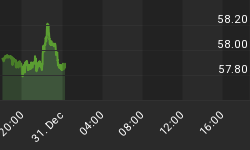More than once has President Trump boasted that his administration has accomplished an “economic turnaround of historic proportions”; but the sheer magnitude of the bill for his economic policies is beginning to become frighteningly clear. Indeed, it is historic. The Treasury Department has just issued its monthly report on receipts and outlays--and it paints a rather gloomy picture that, in short, shows that money is flowing out of government coffers much faster than it’s coming in.
We are at the mid-point of the 2018/2019 federal fiscal year—which runs from October through September. So far, the budget deficit has already hit $691.2 billion dollars, with the government providing estimates for a $1.09-trillion tab for the full year, or more than 4 percent of GDP.
For some perspective, the deficit for the previous fiscal year (2017/2018) clocked in at $599.7 billion at the midpoint, and $779 billion for the full year.
That implies a staggering 40 percent Y/Y increase!
Trump’s $1.5-trillion tax cuts were primarily designed to stimulate growth. In that regard, they performed well for about two years. But now we are seeing a clear reversion to the mean, with the US economy expected to slow down dramatically. The generous cuts have decimated government revenue, ballooning federal budget deficit and forcing Treasury Department officials to cover the gap by borrowing money in unprecedented amounts.
Kicking the can down the road
Both Democrats and Republicans tend to be very vocal about bringing government spending and budget deficits into more sustainable levels—but only when they are not in power. Otherwise, they just say don’t worry about it, essentially kicking the can down the road for future governments to deal with.
Related: Behind The IMF’s Market-Jolting Doom And Gloom
The Government Accountability Office has rendered its verdict: “…federal government’s current fiscal path is unsustainable,” and “the longer action is delayed, the greater and more drastic the changes will have to be.”
Unchecked current account deficits can be a house of cards.
A ballooning deficit means the government has to borrow more heavily to finance its activities including record-high military spending ($956.5 billion in the current fiscal year). Expanding current account deficits means higher Treasury-Bond sales and higher interest rates. Higher interest rates mean higher interest payments and can lead to a vicious cycle of even higher debt. Bear in mind that the current level of national debt is unprecedented for the U.S. at a time of economic prosperity.
In other words, this could end in a very hard landing.
Trade deficit at an all-time high
Not only has the current account deficit been growing but also the US’ balance of trade with its partners has been increasingly been going against it. By the end of 2018, US trade deficit sat at an all-time high $891 billion, the third consecutive year of increases--and it just keeps getting worse.
Funny thing is that the nation’s trade deficit with China—the raison d'être for Trump’s trade war—has continued to expand, hitting a record high of $419 billion last year.
Related: Gold Prices Stuck In Limbo
Trump’s policies though are not entirely to blame. A strong greenback has been encouraging people to buy foreign inexpensive goods while a weakening global economy discouraged foreign buyers of American goods.
Do deficits really matter?
There are two camps when it comes to current account deficits—fundamentalists who view the failure of the 2010 Simpson-Bowles plan that intended to lower deficits as a major misstep and argue that tackling national debt should be made a top priority; and deficit dismissers, on the other hand, who argue that the U.S. can continue ignoring fiscal constraints given prevailing low-interest rates, low inflation and the high appetite by foreign buyers of U.S. bonds.
Deficit dismissers do have a valid point: The long-term structural changes that have allowed interest rates to remain well below their historical mean give room to policymakers to reconsider the traditional fiscal approach that has often limited investments into worthwhile sectors such as healthcare, education and infrastructure.
Policymakers should avoid taking the easy route of trimming entitlement programs such as Social Security and Medicaid and instead should focus on urgent social problems.
On the other hand, fundamentalists are right, too: Debt cannot be allowed to grow forever. The government cannot continue budget policy but continuously failing to enact any guiding principles of what should be allowed and what should not.
Perhaps a middle course would work best.
Instead of making deficit reduction a top priority, policymakers should ensure that, with the exception of periods of economic downturns, fiscal stimulus is only applied when absolutely necessary so that new spending and tax cuts do not add to national debt.
By Alex Kimani for Safehaven.com
More Top Reads From Safehaven.com

















